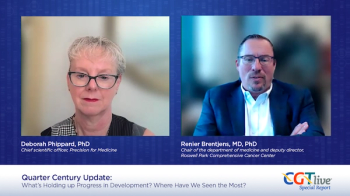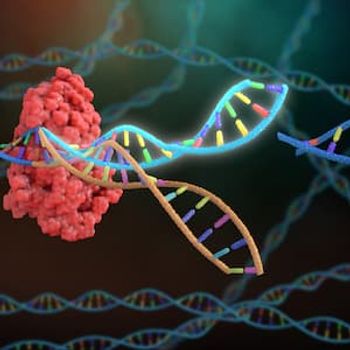
Somatic Mutations in the Ras-MAP Kinase Pathway May Play a Role in Mesial Temporal Lobe Epilepsy
Sattar Khoshkhoo, MD, the founding director of the Epilepsy Genetics Clinic at Brigham and Women's Hospital, discussed his nonclinical research on disease pathogenesis in MTLE.
Although some patients with
In order to gain a better understanding of MTLE, which may open a pathway towards novel, targeted therapies for patients in need, Sattar Khoshkhoo, MD, the founding director of the Epilepsy Genetics Clinic at Brigham and Women's Hospital, and his colleagues have been investigating whether an identifiable genetic basis for MTLE exists. The promising results of their findings from research on patient tissue samples were recently presented by Khoshkhoo at
In an interview with CGTLive™ at the conference, Khoshkhoo discussed the rationale for the research and the key findings. He emphasized that a set of somatic mutations in the Ras-MAP kinase pathway were found to be of particular importance in the MTLE cases they studied.
CGTLive: Can you give some background info on the problem being addressed by your research?
Sattar Khoshkhoo, MD: MTLE is the most common epilepsy type in adults, which accounts for 6 out of 10 patients who come into my clinic. About a third of patients with MTLE have drug-resistant disease... The population of patients who are drug-resistant have the option to undergo epilepsy surgery. Many of these patients benefit from that procedure, however there is still a subset of patients who do not respond to it. In general, we do not have a really great way of figuring out who's going to do well with surgery and who's not. You have certain clinical features such as MRI findings that may help us, but overall, for the most part, there is a paucity of biomarkers that are informative both in terms of predicting surgical outcome as well as biomarkers that would allow us to offer targeted therapies...
Studies that have so far been done under MTLE or other nonacquired focal epilepsies have shown that overall, there's a very low familial burden, meaning that the burden of germline genetic mutations that are inherited from parents and are present in all the cells in the body are unlikely to be contributing to the epilepsy in many of these patients. But in the pediatric epilepsy world, we’ve now known for about a decade that focal epilepsies are frequently caused by what we call somatic mutations, or somatic variants, which are mutation events that happen during development, as opposed to mutations that are acquired from parents and are not going to be present in all the cells in the body. In the case of pediatric epilepsy, many patients actually have mutations specifically restricted to the brain. We know that can be the cause of their epilepsy and importantly, frequently, the specific mutation is informative in terms of how one specific patient is going to do with surgery. It also offers us the possibility of designing drugs that actually target the underlying genetic causes, as opposed to just trying to throw the kitchen sink and see what works. MTLE, being the largest population of patients with epilepsy, I think could really benefit from having that kind of informed approach to care. That was sort of the main impetus for doing this work: to see whether somatic variants also play a part in the process of epilepsy genesis or the process of developing seizures in patients with MTLE.
What were the key findings you presented at the conference?
Building on the findings in pediatric focal epilepsy I mentioned, initially we were interested in identifying a gene or subset of genes that seemed to be implicated in development of MTLE. The first goal was to confirm that these disease-causing somatic mutations are actually present in MTLE cases, as well. Because a significant subset of our patients undergo epilepsy surgery, of course, we had access to tissue and we were able to perform the study by obtaining tissuefrom patients undergoing standard routine epilepsy surgery and then performing deep sequencing to identify the very rare somatic variants, particularly in the protein-coding portion of the genome. Interestingly, we were able to observe that not only are there disease-causing somatic variants in a subset of patients; it turns out that the great majority of them—over 95% of them—are all in the same gene pathway that seems to be sort of involved in the same part of the intracellular machinery. This was very exciting and really strongly suggested that there is a unifying source of disease causation for MTLE. Something that really made this even more convincing is that the Ras-MAP kinase pathway, in which we find these variants, seems to be activated by all of the somatic variants that we identified... And not only that; when we tested other brain regions that we had access to from the surgical resection, we observed that these mutations are only present in the hippocampus, which is the area where seizures in MTLE originally come from, and not the nearby cortical regions, which typically are not associated with seizures.
Transcript edited for clarity.
REFERENCE
Khoshkhoo S. Somatic variants activating ras-mapk signaling cause a spectrum of focal lesions associated with mesial temporal lobe epilepsy. Presented at the 148th Annual Meeting of the American Neurological Association, held September 9-12, 2023, in Philadelphia, Pennsylvania.
Newsletter
Stay at the forefront of cutting-edge science with CGT—your direct line to expert insights, breakthrough data, and real-time coverage of the latest advancements in cell and gene therapy.











































